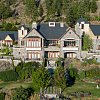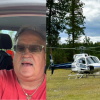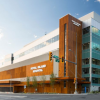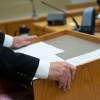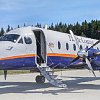For the first time in over 86 years, two sockeye salmon made history by surviving to make the journey partway to their home waters in the upper Columbia River. The pair, released as tiny fry in British Columbia two years ago, are a glimmer of hope for the Indigenous-led push to bring salmon back to their ancestral waters, and they are calling on governments to take immediate action to support the work.
“Those two salmon returning means the chance exists to bring back culture, bring back their language, bring back ceremony and the ability to have our place,” said Mark Thomas, from Secwépemc Nation and chair of the Bringing the Salmon Home executive working group.
(7).jpg)
The Bringing the Salmon Home Initiative — led by the Ktunaxa, Secwépemc and Syilx Okanagan nations in partnership with the governments of BC and Canada — aims to restore salmon runs that were cut off in 1939 during the construction of the Grand Coulee Dam.
As part of the project, over 22,000 juvenile sockeye were released in the upper Columbia in southeastern BC to see if they could survive dam passage, complete their ocean migration and return to their spawning grounds. At least two survived, although neither made it all the way back to where they were released in Canada. This summer, one was detected almost 800 km upstream in Washington State, near Wells Dam. The other was found near Rocky Reach Dam, about 60 km downstream of Wells Dam.
The tagged fish swam back as far as existing dam infrastructure allowed, said Jason Hwang, chief program officer and vice president of the Pacific Salmon Foundation.
Salmon in the upper Columbia face major biological challenges: juveniles navigating predator-filled reservoirs and multiple dams, while adults are blocked by the Grand Coulee and Chief Joseph dams from reaching Canadian spawning grounds. Hwang said salmon are a resilient species that have the potential to sustain and recover if provided with suitable conditions. “They’ve proven the species can still do what nature designed it to do.”
Thomas also pointed out that salmon don’t always return exactly where they spawned. “They have to have some kind of elasticity to their life history in order to explore new ranges and to expand into new territory.”
“We’ve been working hard to make this happen,” said Jason Andrew, from the Ktunaxa Nation Council. “The fact that even two have made it back after all those barriers — that’s no small achievement.”
Thomas said while their success shows salmon can once again complete their life cycle in the upper Columbia River, the releases were only meant to test the waters rather than launch full restoration. The results, he said, serve as “proof of concept” — evidence that with larger releases, the river could one day see salmon return in far greater numbers. “Now that it's happened, it's time for some real work to be put in place,” he said.
The nations want government support to implement fish passage at hydroelectric dams on the Canadian side of the Columbia River, in partnership with Canadian hydro-power operators like BC Hydro and Columbia Power Corporation. This support is needed to address the blockage of salmon access to 40 per cent of the Columbia River's origin area in Canada caused by these dams, which currently have no fish passage.
However, the lack of long-term funding is a massive roadblock and a long journey awaits before salmon can again push past the border and reach the Canadian side of the river.
Thomas said the roughly $5-million commitment from the British Columbia Salmon Restoration and Innovation Fund, which is ending soon, primarily supports science and experimentation rather than essential management, staffing and administrative functions. “We need money to manage these programs…to keep the lights on, to pay rent for our office,” Thomas said.
Indigenous communities should not bear the full cost of salmon restoration because decades of industrial activities and commercial fishing have drained billions of dollars’ worth of salmon and ecosystem resources — profits that were never reinvested back into the land or its people, he said. This exploitation has left Indigenous nations disproportionately responsible for healing and restoring the environment.
Andrew said the restoration journey can’t be carried on hope alone — Indigenous communities need more than short-term funding to make real progress and not lose momentum. "We can’t keep patching things year to year when the work demands plans that span five, 10 years,” he said.
Indigenous nations are calling on the federal and BC governments to finalize an agreement by January 2026 that formally commits to long-term, sustained funding for salmon restoration in the Columbia River.
Hwang said restoration will require stable, multi‑year funding rather than the short one‑ or two‑year project allocations currently provided.
He pointed to the Okanagan Nation Alliance’s salmon restoration work as a model. Indigenous-led efforts that began with similar pilot releases in the 1990s have since grown into a thriving conservation program, with more than 300,000 sockeye salmon returning to their traditional spawning grounds in Canadian waters. “In the mid‑’90s, people said you couldn’t bring sockeye back to the Okanagan,” Hwang said. “Now there are hundreds of thousands returning. That’s what’s possible when you fund it properly and stay committed.”
The Columbia River watershed doesn’t stop at national borders — it weaves its way across the line between Canada and the United States, adding yet another layer of complexity to the salmon’s remarkable journey, Hwang said. The young fish begin their lives in British Columbia but their migration takes them deep into US waters before they fight their way back home, making cross-border coordination essential. Governments, agencies and Indigenous nations on both sides need to be working together to keep the path open for the salmon’s return.
"The recent return of adult sockeye salmon to the Columbia River is a meaningful reflection of what can be achieved through collaborative effort. Canada values the opportunity to contribute to this important work, which honours Indigenous leadership and knowledge, and supports ecological restoration efforts to benefit salmon," said Lara Sloan, a spokesperson for Fisheries and Oceans Canada in an email response to Canada's National Observer.
A spokesperson for the Ministry of Water, Land and Resource Stewardship said the return of juvenile sockeye salmon to the upper Columbia River marks a significant milestone in the long-term Bringing the Salmon Home initiative. British Columbia has supported the project with more than $5.2 million through Phase 2 of the B.C. Salmon Restoration and Innovation Fund, in addition to over $1.5 million contributed since 2019 under the tripartite memorandum of understanding, with another $500,000 committed through 2026–27.
"B.C. is committed to continuing to recover salmon by working with communities, Indigenous partners, local groups and the public on habitat restoration and reintroduction," the spokesperson said.
Salmon returning today show what is possible when Indigenous communities lead, Thomas said. “We’ve proven what’s possible when salmon are given a chance… The fish have finally made it home — it’s time we make sure they can stay.”
Sonal Gupta / Local Journalism Initiative / Canada’s National Observer








(7).jpg)
